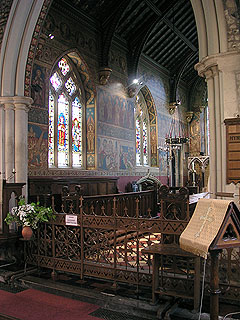The south-eastern corner of Cambridgeshire is, I think, the most beautiful bit of the county. The land rises and falls in gentle undulations (I suppose I ought to mention the Gog Magog hills but I won't dignify them with the title of 'hill'). Little rivers wind their way through gently wooded valleys, and it's all very idyllic - you can tell we're getting towards the lovely Stour Valley landscape of southern Suffolk and northern Essex. Hildersham is in the middle of all this, and Holy Trinity revels in a position on a gentle rise above the river - the infant Granta, on its way to the Abingtons. The churchyard has probably the most impressive copper beech I've seen for ages. The church, from the exterior, doesn't live up to its position - all the tell-tale signs of a strong Victorian influence are here. We entered, expecting the usual blandness.
Well, Hildersham is certainly Victorian, but bland it is not. The nave - mostly Decorated - is short and very tall. It is also very dark, due to the splendid, dark Victorian glass in the clerestory and aisle windows, and the fact that the stone is left without whitewash. Painted shields adorn the corbels, and there are two doorways into the tower - it could almost be a medieval dining hall from a rather inaccurate film. The chancel, though, is extraordinary. Pevsner, with his usual disdain for Victoriana, writes 'The aisle windows and chancel and s transept windows all very restored or renewed', and leaves it at that. To suggest that this is of the same order as the usual lacklustre restorations of the period, though, is ridiculous, for this is glorious. The chancel has been completely rebuilt and is richly frescoed throughout in dark reds, and greens, with gold glinting darkly in the gloom. The east window is filled with a tree of Jesse which glows like jewels, and there is a very good marble reredos behind the altar. The decoration is due to James Goodwin and his son Charles, both rectors here for the 19th century (between them occupied the living from 1806 to 1900). In the 1970s a thorough restoration was performed by Stephen Dykes Bower, cathedral architect over at Bury St Edmunds. The effect is very rich and thoroughly unlike anything else in the county. It's an acquired taste, but I very much like it.
Alas, the closest one can get to the chancel is the arch. Beyond, it is alarmed - no doubt as a result of the theft in 1977 of two splendid oak effigies from the middle of the 14th century. They were life size, and probably represented Sir William Busteler and his wife Margaret. A rather forlorn appeal in the guidebook says 'If any visitor should ever see the effigies in a museum or private house anywhere, but more probably abroad, the church-wardens would like to be informed'. Amen to that.
Holy Trinity was open when we visited
